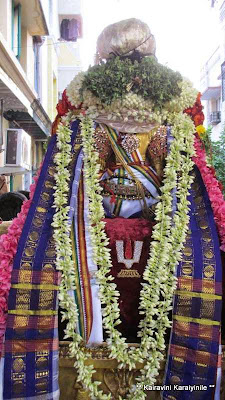Today 22nd July 2013, is a very
important day for Sri Vaishanavites. Today being Uthirada Nakshathiram in
the month of Aadi, marks the birth of a great Acharyar – Aalavandar.
Known as Yamuna Muni, Yamunaithuraivar, Alavandar was the grandson of Sri
Nathamunigal and son of Ishwara Munigal and Sri Ranganayaki.
Every summer gives trouble not only of
sweltering heat but of the water shortage to the residents of Chennai. Though there are four reservoirs of Poondi,
Cholavaram, Redhills and Chembarakkam as lifelines for drinking water needs of
Chennaites, there is another important water source that supplements daily
water supply to the city and that is more than two hundreds of kilo meters away……
it is the Veeranam lake in Cuddalore from which water is brought in by 230 km
long pipeline. The lake of veeranam lake
mentioned in ‘Ponniyin Selvan’ is located 14 km SSW of Chidambaram and 1 km off
Sethiyathope. The lake built by Chola
kings provides water to the metropolis.
The Veeranam lake derived its name from the
nearby place ‘Veera Narayana puram’ which is of great significance to
Srivaishnavaites. It is here that our
Acharyars Nathamunigal and later Sri Alavanthar were born. Alavanthar was born
at Viranarayanapuram (present day Kattu Mannargudi) in Tamil Nadu. Yamunacharya
was a genius – a child prodigy known for his prowess of eka-santha – graha (remembering forever by
learning only once). He was known for his sparkling intelligence, didactic
logic and exceptional devotion to Sriman Narayanan. His defeating a much
learned Akkiyalvan is very famous. After the debate, the Queen hailed
Yamunar as 'Alavandar'-' one who came to rule / save me'.
It was due to the ceaseless efforts of Sri
Rama Mishra (Acharyar Manakkal nambi), the desciple of Uyyakkondar that
Yamunacharyar was initiated back to the spiritual life. Sri Rama mishra
initiated Yamuna into the ultimate truths and passed to him the spiritual
treasures bequeathed to him by Sri Nathamuni. After the initiation, Yamuna
became the leader of Visistadvaita Vedantins and settled at the holy place of Thiruvarangam.
He gave our Sampradhayam, priceless treasure-trove of 8 works of which most
important are the : Chatusloki on Pirattiyar; Sthothra Rathinam extolling
Emperuman; Sri Geethartha Sangraham, which formed the basis for Udayavar’s Gita
Bashyam. He identified and gave us the Greatest of Acharyas – ‘Sri Ramanujar’
as he spontaneously called Udayavar ‘He is the First of all [aa muthalvan
ivan]’
Today is also ‘Gajendra Moksham’ – the day when
Lord atop Garuda rushed to save His devotee – the pious elephant stricken by a
crocodile. This episode was enacted in the ‘Kairavini pushkarini’ – the
beautiful lotus pond of Sri Parthasarathi. Sri Parthasarathi Perumal had purappadu in Garuda vahanam ~ Thirumangai mannan says 'aanaiyin thuyaram theera aazhi thotta perumal" - the Lord touched His Chakra for alleviating the tears of elephant Gajendra.....
இன்று (22.07.2013) ஆடி மாத
உத்திராட நக்ஷத்திரம். பௌர்ணமி கூடிய சுப நாள். ஸ்ரீவைஷ்ணவர்களுக்கு சீரிய நாள். ஆச்சார்யன் ஆளவந்தார் சாற்றுமுறை - கூடவே கஜேந்திர மோக்ஷம்.
ஸ்ரீ வைஷ்ணவ ஸம்ப்ரதாயத்தின், அடிப்படையே
குருபரம்பரை தான். நம் ஒவ்வொரு செயலும் மங்களம் பெறச் செய்வது, ஆசார்ய ஸம்பந்தம் மட்டுமே.
ஸ்ரீ வைஷ்ணவ ஆசார்ய பரம்பரை ஸ்ரீமந்நாராயணனிடமிருந்து தொடங்குகிறது. பிராட்டியார், சேனை
முதலியார், ஸ்வாமி நம்மாழ்வார் என்னும் வரிசையில் நாதமுனிகள். ஸ்ரீமன் நாதமுனிகளுக்கு
பிறகு - உய்யக்கொண்டார், மணக்கால் நம்பி, அடுத்ததாக யாமுனாசார்யர் என்கிற ஆளவந்தார். நம்முடைய தர்சனத்தில்,
ஆளவந்தார் வித்வத் சார்வபௌமர். பூர்வ ஆசார்யர்களுள் யமுனைத்துறைவரும் (ஆளவந்தார்), ஸ்ரீ
பராசர பட்டரும் மிகச் சிறு வயதில் பெரிய அறிஞர்களை வாதத்தில் வென்று தம் புலமையை வெளிப்படுத்தியவர்களாவர்.
நாலாயிர திவ்ய பிரபந்தம் தொகுத்த நமக்கு
அளித்த நாதமுனிகளின் புதல்வர் ஸ்ரீஈஸ்வர முனிகள். அவரது குழந்தைதான் ஆளவந்தாரான யமுனைத்துறைவர்
எனப்படும் யாமுனாசாரியர். திருவரங்கத்து அமுதனார் தமது 'இராமானுச நூற்றந்தாதியில்'
யமுனைதுறைவனின் திருவடி சம்பந்தத்தால், நம் உடையவருக்கே சிறப்பு என அருளிச் செய்துள்ளார்.
நிதியைப் பொழியும் முகில்என்று* நீசர்தம் வாசல்பற்றித்
துதிகற் றுலகில் துவள்கின்றிலேன், இனித்*
தூய்நெறிசேர்
எதிகட்கிறைவன் யமுனைத் துறைவன் இணையடியாம்
கதிபெற் றுடைய* இராமானுசனென்னைக்
காத்தனனே.
- மிக உயர்ந்த முனிவர்களுக்கு
எல்லாம் தலைவரான ஆளவந்தாருடைய திருவடிகளை
உபாயமாகப் பெற்று, இவ்வுலகத்துக்கே தலைவரான எம்பெருமானார்
நம்மை காத்து அருள்வார்.
நாதமுனிகளும், யாமுனாச்சார்யராகிய
ஆளவந்தாரும் பிறந்த திருத்தலம், ‘காட்டு மன்னனார் கோவில்’. வீரநாராயணபுரம் என
சோழர்கள் காலத்திலும் தற்கால வீராணம் ஏரி உள்ள இடத்தில் உள்ள கோவில் ஆளவந்தாரின்
அவதார திருத்தலம். இளம்வயதிலேயே வித்வஜ்ஜன கோலாகலர் என்றும் அக்கியாழ்வான்
என்றும் புகழ்பெற்ற அறிஞரை வாதத்தில் வென்றார். தனது பன்னிரண்டாம் வயதிலேயே இச்சிறப்பு
பெற்றதால் ஆளவந்தார் என புகழ் பெற்றார். மணக்கால் நம்பிகள் ஆளவந்தாரை ஸ்ரீரங்கத்துக்கு
அழைத்து சென்று ரங்கநாதரைக் காட்டி குலதனம் என்று நம்பிகள் ஒப்படைத்தார். ஆளவந்தாரும்
தம் போக வாழ்க்கையை அக்கணமே துறந்து துறவியாகி ஆன்மீகப்பேரரசரானார். ஆளவந்தார் ஒரு
சமயம் திருக்கச்சியிலே இளையாழ்வான் ஆன ராமானுஜரை கண்டு 'ஆ முதல்வனிவன்'
என ஸ்லாகித்து பின்பு பெரிய நம்பியிடம்
ராமானுஜரைப் பற்றி கூறினாராம்.
ஆளவந்தார் அருளிச் செய்த நூல்கள்
" எட்டு "" - இவற்றுள் ஸ்தோத்ரரத்னம், சதுஸ்லோகி, சித்தித்ரயம், ஸ்ரீ கீதார்த்த ஸங்க்ரஹம், ஆகமப்ராமாண்யம், மகாபுருஷ நிர்ணயம் இவை முக்கியமானவை.
Here
are some photos taken during today’s purappadu at Thiruvallikkeni divyadesam
Adiyen
Srinivasadhasan



















































